Physical Education Unit 2 AOS 1
1/93
There's no tags or description
Looks like no tags are added yet.
Name | Mastery | Learn | Test | Matching | Spaced |
|---|
No study sessions yet.
94 Terms
physical activity
any movement of the body produced by skeletal muscles, resulting in energy expenditure
Types of physical activity
-play
-games
-sports
-active transportation
-chores
-exercise
-recreational activities
play description, characteristics and examples
activities engaged in for enjoyment and recreation rather than a serious or practical purpose.
-spontaneous
-enjoyable
-flexible
-intrinsically motivated
Examples:
-playground games
-monkey bars
-sandbox play

games description, characteristics and examples
activities engaged in for enjoyment
-rules exist
-goal-oriented
Examples:
-virtual reality
-octopus tag and yard games
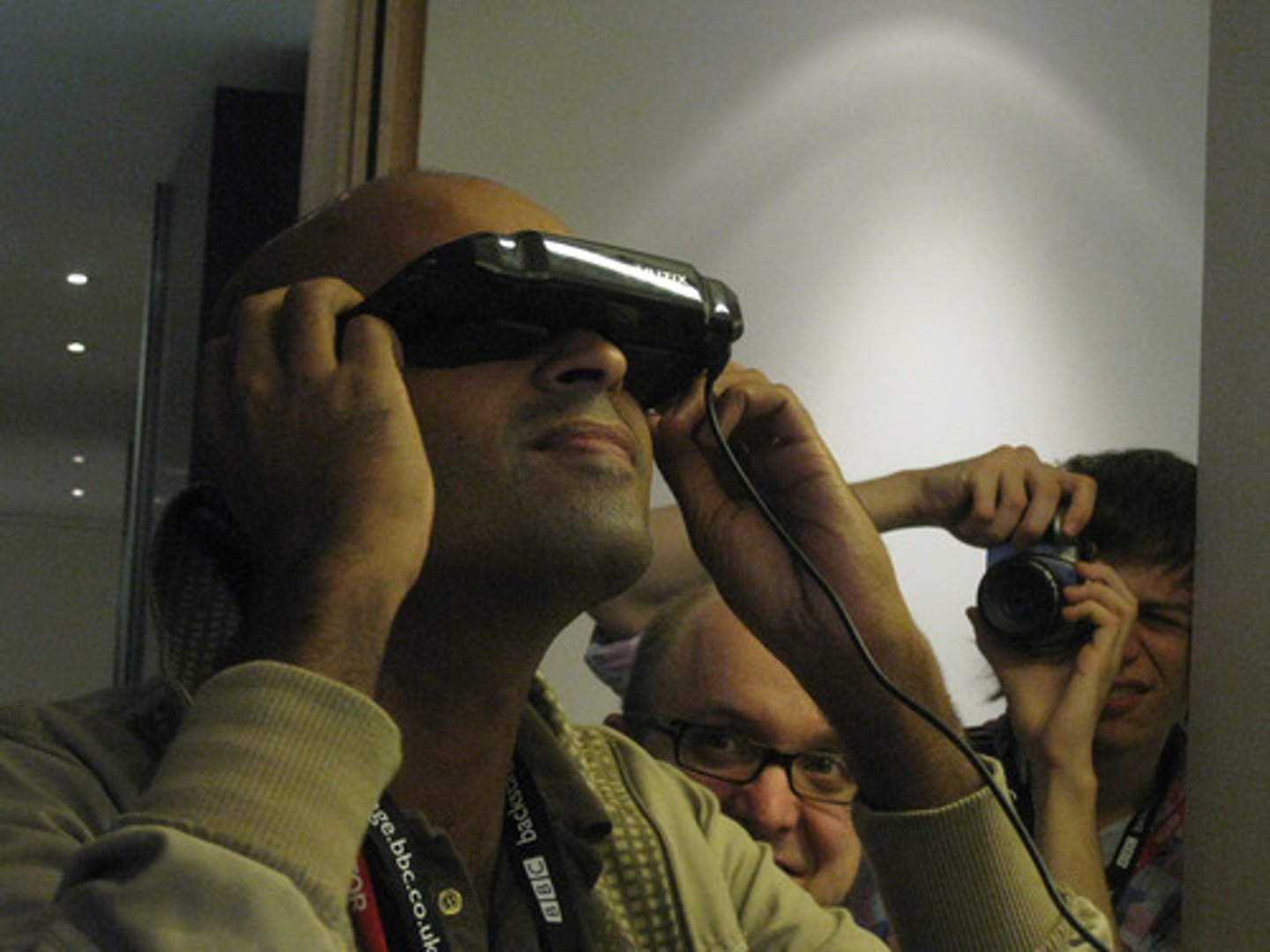
sports description, characteristics and examples
activities involving physical exertion and skill, in which an individual or team competes against another for entertainment
-highly organised
-structures
-strict rules
-competitive
Examples:
-AFL
-basketball
-soccer
-tennis
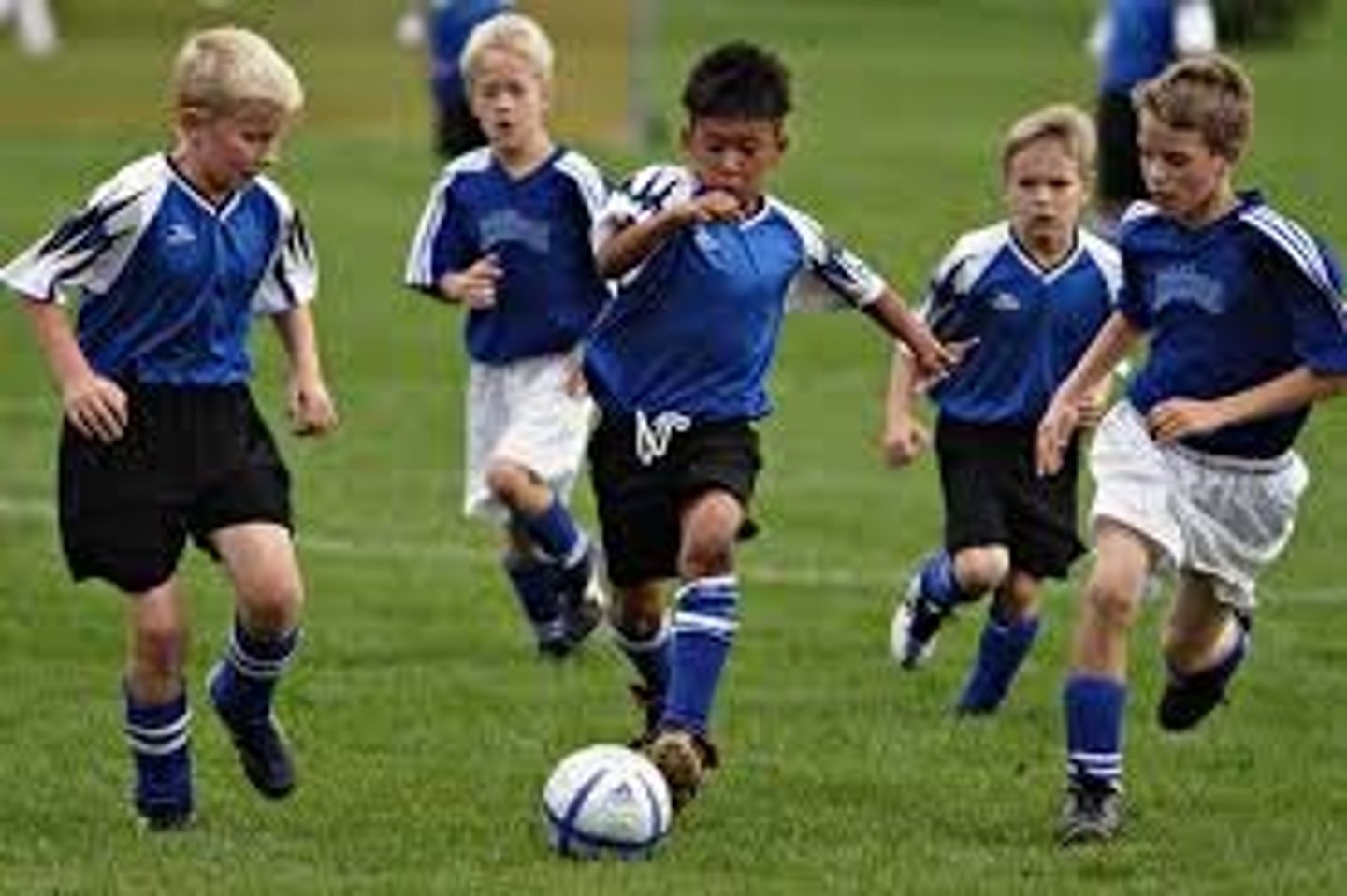
informal sports description, characteristics and examples
self-organised activities with adaptable rules and organisation
-self-organised
-casual
-flexible rules
-less structured
-operates independently from formal structures
Examples:
-street soccer
-3 on 3 basketball
-beach cricket
-spikeball at the beach
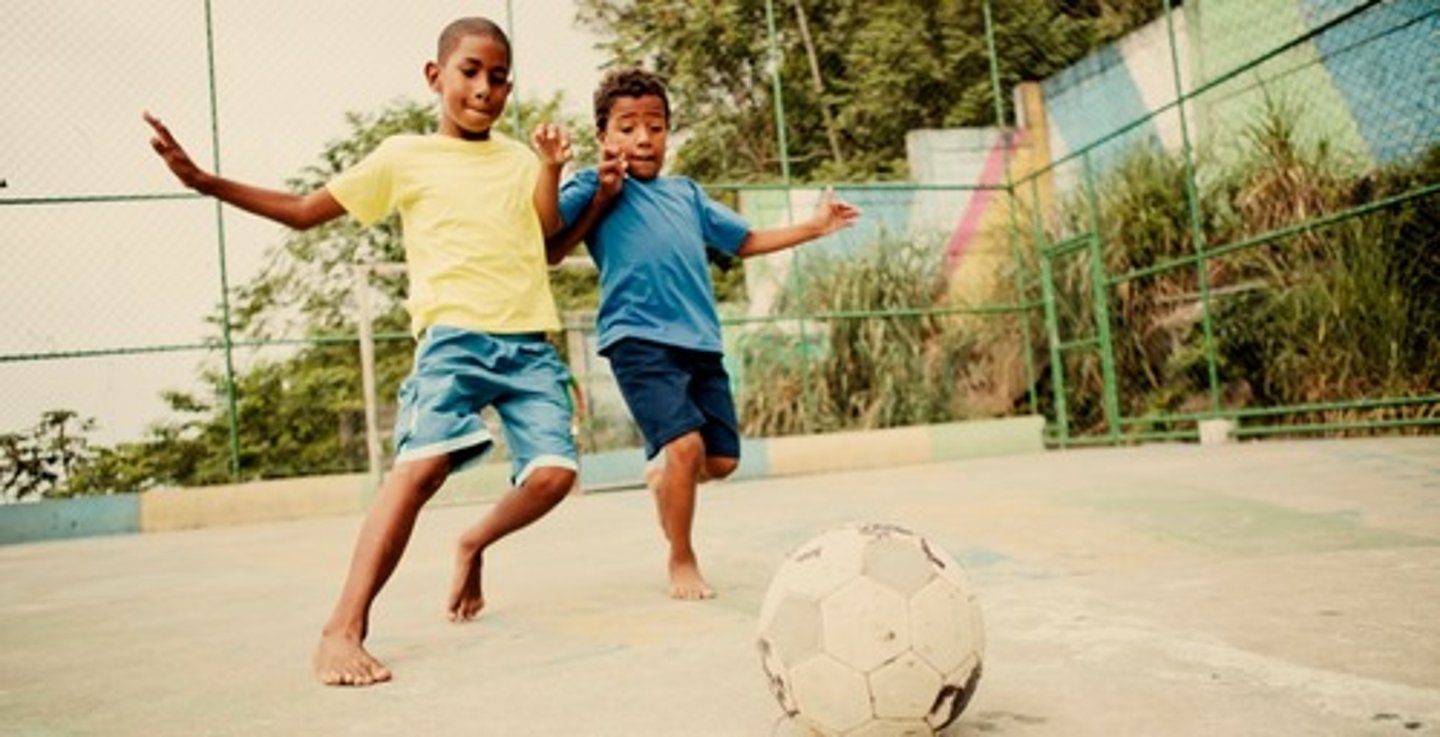
active transportation description, characteristics and examples
travel between destinations that involves physical movement
-practical
-purpose-driven
Examples:
-walking
-cycling
-running
-skateboarding

exercise description, characteristics and examples
activities requiring physical effort that are carried out to sustain or improve health and fitness
-health-focused
-routine
-involves physical exertion
Examples:
-aerobics
-weightlifting
-running
-cycling

chores description, characteristics and examples
routine tasks for example, jobs done around the home
-repetitive
-task-oriented
-necessary
Examples:
-gardening
-cleaning
-grocery shopping

recreational activities description, characteristics and examples
leisure activities. Leisure is discretionary time, which is time outside of work and study commitments.
-relaxing
-fun
-diverse
Examples:
-fishing
-dancing
-skydiving
-surfing
-paragliding
-hot-air ballooning
-scuba diving
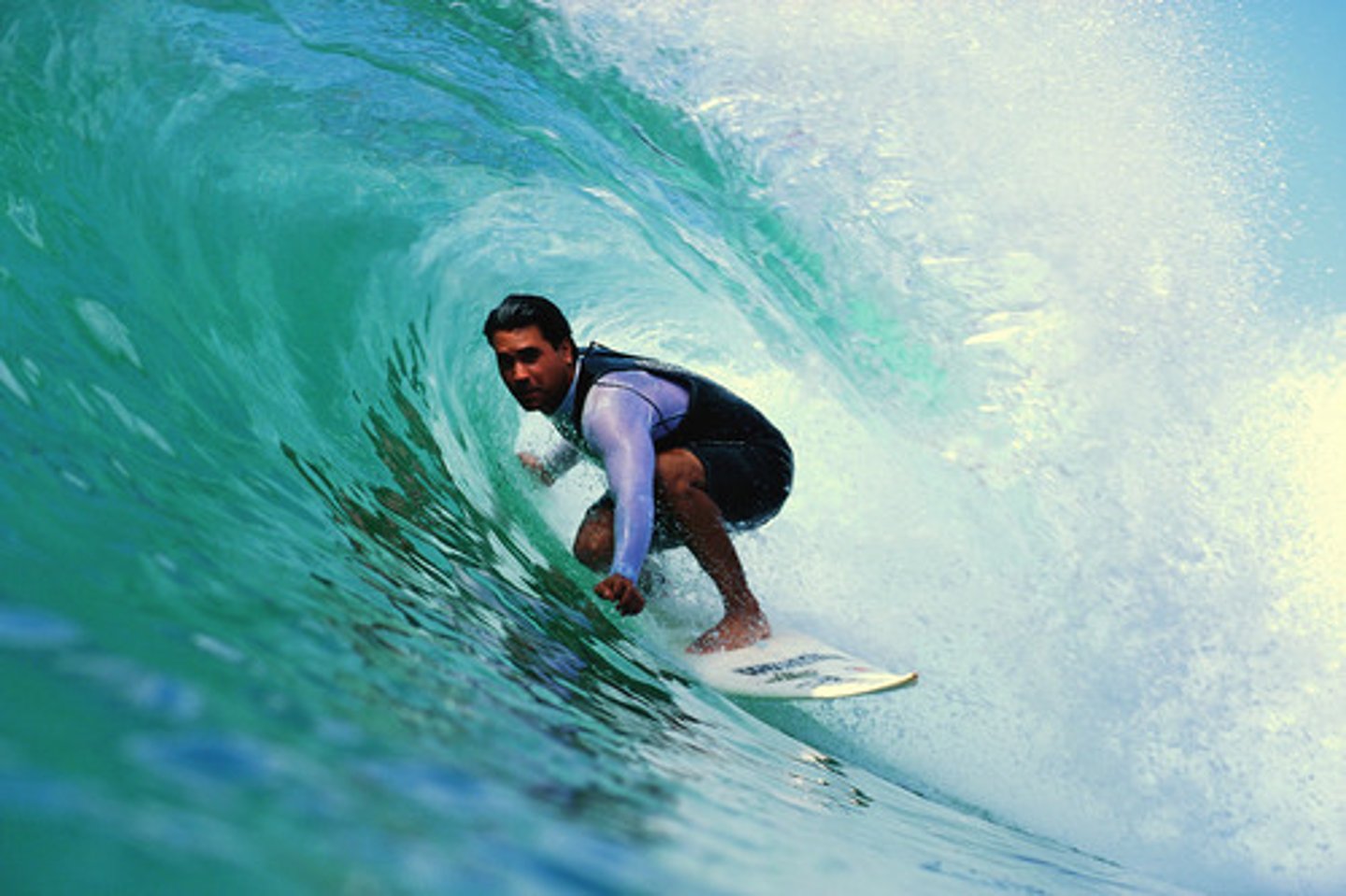
physical inactivity
a lack of involvement in physical activity during an individual's leisure time.
sedentary behaviour
behaviour associated with sitting or lying down, including activities such as watching television, working or playing on the computer, driving or sitting in a car, bus or train. It also includes homework, studying or reading.
Enabler
something that makes it possible for a particular thing to be done
Barrier
something that prevents progress or makes it difficult for an individual to achieve something
Family enablers and barriers
Enablers:
Role models- active family members modelling physical activity
Resources- providing access to sports equipment and coaching
Encouragement- verbal encouragement and support for physical activities
Shared activities- inclusion in shared activities such as hikes or bike rides
Opportunities- creation of opportunities for physical activity through active family members
Barriers:
all the same but put "lack of" at the start
Peer enablers
Motivation to participate- desire to be a part of a friendship group
Support and encouragement- providing essential support and encouragement, vital for staying active, especially during recovery from injuries
Accountability and performance- friends can serve as gym buddies, fostering accountability for regular exercise, and competitive but friendly rivalries can enhance performance
Peer barriers
Social exclusion- in skill based sports, not matching the proficiency levels of friends can diminish motivation and lead to avoidance of physical activity
Undervaluing physical activity- if the peer group undervalues physical activity in favour of sedentary activities, such as video gaming, individuals are likely to mirror these habits, reducing physical activity levels
Socioeconomic status enablers
Income- high incomes facilitate access to a diverse range of exercise facilities and equipment
Occupation and education- higher levels of occupation status and education lead to a greater understand of the benefits of physical activity
Access to equipment- higher SES provides the ability to afford personal fitness equipment or gym memberships
Socioeconomic status barriers
Income- low incomes may restrict access to exercise facilities and equipment
Chronic diseases- having lower SES is associated with higher rates of chronic diseases, hindering physical activity
Transportation- having lower SES may limit efficient transportation options to physical activity venues
Gender barriers
Role models- women are underrepresented in sports, leading to lack of advocacy for women's needs
Gender stereotypes- prevailing stereotypes deter women from participating in activities perceived as 'masculine'
Limited opportunities- societal norms constrict opportunities for women, such as men occupying women's playing areas
Media coverage and sponsorship- limited media coverage leads to fewer sponsorship opportunities
Cultural norms enablers
Multilingual information- providing program details in multiple languages to improve accessibility
Role models and awareness- promoting multicultural role models and awareness programs
Cultural accessibility- adjusting programs to be culturally sensitive and inclusive
Community enablers
Availability of sports- regional preference can boost participation and interest in these sports (eg. rugby in QLD)
Safety- safe communities that cater to the needs of the public are more likely to see increased physical activity.
Community barriers
Availability of sports- in country towns, it can be challenging to find enough people to fill sporting teams, which reduces opportunities
Safety- high crime rates may deter people from engaging in outdoor activities such as running, walking, or bike riding, due to safety concerns.
METs (metabolic equivalents)
commonly used to express the intensity of physical activities. A MET is the ratio of a person's working metabolic rate relative to the resting metabolic rate. Your MET level would be 1 if you were generally sedentary (e.g. lying down, reading or sitting and talking). Participation in an activity of moderate intensity would result in a MET level of 3-6.
Physical benefits of regular physical activity
-healthy body weight
-boosted immune system
-reduced health risks
-stronger muscles
-improved cardiorespiratory system
-healthy bones
-increased energy levels
Mental benefits of regular physical activity
-self-confidence
-self-esteem
-positive thought patterns
-reduced stress levels
-improved thinking and information processing
Emotional benefits of regular physical activity
-positive mood
-resilience
-appropriate display of emotions
Social benefits of regular physical activity
-improved communication skills
-reduced feelings of isolation and loneliness
-wider exposure to new people
-improved relationships
-increased trust in others
Spiritual benefits of regular physical activity
-deepened connection to nature
-enhanced sense of mindfulness and spiritual awareness
-elevated state of serenity
-improved sense of belonging
Type 2 diabetes
a condition that affects how the body uses sugar (glucose) for energy and stops the body from using insulin properly.
(inability of the pancreas to control blood sugar levels)
-generally caused by lifestyle choices
-positive lifestyle choices that people can make include eating more nutritious foods, reducing kilojoule intake and engaging in more physical activity.
Osteoporosis
characterised by a reduction in bone density
children and adolescents are strongly encouraged to develop the largest bone density possible by:
-ensuring sufficient calcium intake (dairy foods, vitamin D from the sun.)
-weight-bearing activities such as soccer, running and netball. High impact actions such as jumping (e.g. in gymnastics or dance) and jumping rope develop bone growth.
Cardiovascular disease
A collective term that covers diseases of the heart and blood vessels.
-a range of lifestyle choices that individuals can make to decrease the risk of cardiovascular disease, such as not using tobacco products and consuming a healthy diet, which is low in saturated fats.
-Physical inactivity is also a major risk factor for cardiovascular disease. By making healthy lifestyle choices, such as eating well and exercising, other risk factors for cardiovascular disease can be controlled
Obesity
-two out of three Australian adults are overweight or obese
-individuals carrying excess fat (adipose) tissue
-this is the result of an energy imbalance
-energy expenditure depends on duration and intensity
Cancer
a term to describe the abnormal growth and multiplication of the body's cells.
-there is a link between some cancers and overweight and obesity
-regular physical activity can help maintain body weight and therefore decrease the risk of cancer.
Physical activity recommendations 0-5 years
Infants (0-1)
-supervised interactive floor based play
-at least 30 mins of tummy time over the course of the day while awake, including moving their arms and legs
-reaching and grasping objects
-crawling
-pulling up into standing position
-walking (in some cases)
Toddlers and children (1-5)
-get at least 3 hours of various physical activities each day, including energetic play (running, twirling and jumping, dancing)
Sedentary behaviour and screen time recommendations 0-5 years
-no screen time for children under 2
-no more than 1 hour a day for children aged 2-5
-toddlers should not be restrained from more than one hour at a time
-inactivity should involve educational activities, such as reading, singing or painting.
Physical activity recommendations 5-17 years
-at least 60 minutes of moderate/vigorous activity every day
-at least 3 days/week, incorporate activities that strengthen muscle and bone (eg. running, climbing, lifting weights)
Sedentary behaviour, sleep and screen time recommendations 5-17 years
-no more than 2 hours of sedentary recreational screen time
-break up long periods of sedentary behaviour
Sleep:
-children aged 5-13 get 9-11 hours uninterrupted
-young people aged 14-17 get 8-10 hours uninterrupted
-have consistent sleep patterns
-avoid screens 1hr before bed
Physical activity recommendations 18-64 years
-should be active most days, preferably every day
-either 2.5-5 hours of moderate physical activity, or 1.25-2.5 hours of vigorous physical activity
-include muscle strengthening 2 days/week
Sedentary behaviour recommendations 18-64 years
-reduce the time you spend sitting
-break up long periods of sitting
Physical activity recommendations 65+ years
-at least 30 minute of moderate physical activity on most or all days
-can start with just 10 minutes and build up if physical activity is difficult
-incorporate muscle strengthening activities
Sedentary behaviour and screen time recommendations 65+ years
-reduce/break up time sitting down
Physical activity assessment tool: diaries
a subjective method of assessing levels of physical activity and sedentary behaviour. Diaries can capture information about the individual's activities, including how often, how hard and how long they exercise for, along with the exercises they tend to do. They can also help to understand underlying patterns (eg. enablers and barriers)
Advantages of diaries
-can be used to record information whenever it is desired by those administering the test
-the person filling out the diary doesn't have to recall information over a prolonged period, improving accuracy
-ease of administration
-low cost
Disadvantages of diaries
-may become a burden to the person as they have to input information regularly
-respondents become reactive to the present of the assessment tool and therefore temporarily increase their physical activity levels
-prone to social desirability bias
-compared with surveys, diaries tend to have less prescriptive questions, and it is therefore harder to compare responses from different people
Physical activity assessment tools: wearable devices
an objective measure of physical activity. devices equipped with sensors, processors, memory and software with algorithms.
-help users understand their movement patterns over time and improve their daily lives, which includes preventing injuries from excessive overload.
-often feature accelerometers and inclinometry
-increasingly personalised, enhancing the accuracy of data collected.
Advantages of wearable devices
-can provide rich real-time data for the individual
-have the capacity to measure physical activity and sedentary behaviour
-has the capacity to measure any dimension
-can be used in many different contexts (eg. outdoor, water, remote locations and inside)
Disadvantages of wearable devices
-can be expensive (especially those with advanced features)
-can still cause some reactivity (although less than other tools such as pedometers)
-individual differences in physiology may lead to inaccurate results
-some people many find it challenging to use the technology in a meaningful way
Physical activity assessment tools: digital tools
an objective measure that includes tablets, computers and smartphones. It uses application and software programs to track physical activity and sedentary behaviour levels. (eg. Strava is an app that many athletes use to measure their progress over time)
Advantages for digital tools
-has the capacity to measure physical activity and sedentary behaviour
-allows individuals or coaches to review in-depth data to make future decisions about physical activity
Disadvantages for digital tools
-can be expensive (especially those with advanced features)
-some people may find it challenging to use the technology in a meaningful way
-requires continual internet access, which may be difficult in some locations
subjective
judgement made by an observer with a set criteria
objective
judgement that is based on something that can be measured by units of time, distance or some other measurements/units
Health related fitness components
-aerobic power
-muscular strength
-muscular endurance
-flexibility
Aerobic power
the maximum rate of energy production from the aerobic energy system
Aerobic power is important for
-active transport
-endurance activities, such as marathons
-most team sports, such as AFL
-some active play, such as tiggy
Muscular strength
the peak force that a muscle can develop
Muscular strength is important for
-arms on the monkey bars
-legs while climbing stairs
-weightlifting
-core, back and arms doing landscaping/gardening
Muscular endurance
the ability of a muscle group of muscles to sustain repeated or sustained contractions against resistance for an extended period
Muscular endurance is important for
-arms, legs and abdominals for a tennis player in a long rally
-abdominals during a static hold such as a plank
-legs walking up a long hill
Flexibility
the range of movement around a joint
Flexibility is important for
-gymnastics
-ballet
Functional Movement Assessment (FMA)
involves observing the participant through a variety of movements to inform the design of a physical activity plan
What the FMA does
involves an observation of the participant through a variety of physical movements, which are then evaluated to determine the efficiency of their movement in preparation for prescribing safe physical activity within a personalised activity plan.
(lower score=increased risk of sustaining musculoskeletal injury)
Results should be valid, accurate and reliable
Frequency (FITT)
how often per week physical activity is completed
Intensity (FITT)
level of physical exertion or how hard you work (light, moderate, vigorous)
Type (FITT)
the mode of activity being undertaken (eg. aerobic, such as cycling)
Time
how long you are active for, usually measured in minutes.
SMARTER Goals
Specific
Measurable
Accepted
Realistic
Time-framed
Exciting
Recorded
Specific (SMARTER)
make your goals as specific and detailed as possible
Measurable (SMARTER)
your goals should be measurable and assessed against a standard of previous performance, otherwise there is no way of determining whether or not you have achieved them
Accepted (SMARTER)
all of the parties involved in the setting of the goals (eg. the individual, trainer, coach) should accept them
Realistic (SMARTER)
your goals need to be challenging, but also achievable. Goals should be framed in a positive manner and focused most importantly on improvement.
Time-framed (SMARTER)
short-term and long-term goals should be set and there should be a specific date for when they will be achieved.
Exciting (SMARTER)
the goals set should challenge, excite and inspire the individual
Recorded (SMARTER)
the agreed goals should be recorded by the individual and trainer/coach so as to provide a constant reminder and to act as a source of motivation.
physical activity plan vs activity plan
A physical activity plan focuses on increasing movement and physical activity for health benefits, while an activity plan is a broader concept that can encompass various activities, including those related to work, hobbies, or daily life.
socio-ecological model
a framework used to develop, implement and critique health-promotion strategies aimed at improving health by promoting physical activity and limiting sedentary behaviour
Individual (SEM) and examples
learning the benefits of this particular exercise routine from the teacher/instructor promotes a positive attitude towards movement
Eg. beliefs, perceived barriers, age, gender.
Individual factors (SEM) the influence on PA and SB
Knowledge and education- understanding the benefits and consequences of physical inactivity
Perceived barriers- obstacles that a person believes in stop them from engagement in physical activity (eg. lack of time)
Motor skills- the ability to perform physical tasks that require voluntary movement from the muscles
Social environment (SEM) and examples
encouraging peers to exercise together can help reinforce a positive attitude.
Eg. family, peers, SES of community, cultural norms and background
Social factors (SEM) that influence on PA and SB
Family- the activity levels of parents and siblings serve as models for children, influencing their physical activity habits. Family support through funding and transportation is also significant.
Peers- peers of similar age can positively or negatively influence an individual's activity levels, through encouragement or the lack of it.
Social support- living in a community with strong social support networks can encourage greater levels of physical activity
Physical environment (SEM) and examples
a location that allows physical activity (eg. gymnasium with enough space) helps create and active lifestyle.
Eg. safety, availability and access to sport and recreation facilities
Physical environment (SEM) influence on PA and SB
Availability and access- the presence of parks, playgrounds, tracks, gymnasiums and sports fields can encourage physical activity by providing the necessary infrastructure for a variety of sports and exercises.
Aesthetics- refers to the perceived qualities of a particular facility or environment. The visual and physical appeal of an environment or facility can enhance or diminish the desire to engage in physical activities in that space.
Geography- refers to Earth's landscapes, environments, and relationships between people and their surroundings.
Policy (SEM) and examples
funding for equipment that supports the activity (eg. mats to exercise on), encourages physical activity behaviour
Eg. urban planning policies, education policies, funding policies
Policy (SEM) influence on PA and SB
Urban planning policies- policies mandating land reservation for parks and gardens, and the inclusion of footpaths and bike paths in urban design influence physical activity levels
Education policies- rules enforced by schools can either promote or deter physical activity, including compulsory PE classes, sports equipment provision and bike rack access. Conversely, restrictions on sports uniforms. certain grounds and access to equipment for safety reasons can deter activity
Workplace policies- policies in the workplace that encourage physical activity, such as walk and talk meetings, discouragement of elevator use and provision of standing desks.
Evaluating activity plans (flow chart)
Was the plan effective?
Yes (many positives, met goals, met individual needs) -> maintain positive aspects, but consider applying some variety to maintain motivation. (eg. change location of run)
Somewhat (some positives, not fully meet goals, did not improve PA or SB)
No (negatives, did not meet goals or individual needs) -> critically review the negatives and make necessary changes (maybe repeat FMA or gather extra info from participant)
Evaluation of activity plan steps
1. Record current levels of physical activity and sedentary behaviour
2. compare the current levels to initial levels. Personal reflections should include information regarding the impact of physiological, psychological and sociocultural factors.
Borg Rating of Perceived Exertion (RPE)
used to subjectively measure how hard your body works during physical activity. It uses numbers to rate how much effort an activity takes. The RPE scale can help you manage exercise intensity and improve cardio training and endurance.
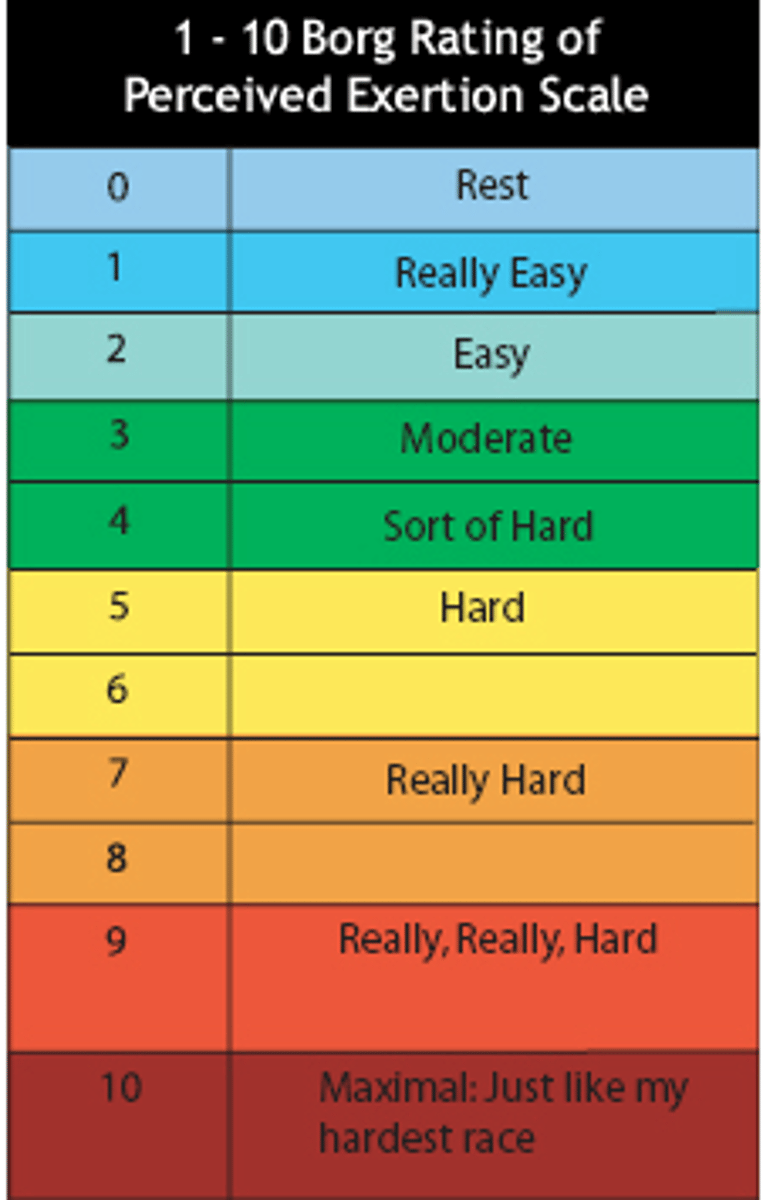
Contemporary issue: hormonal considerations
Hormones are chemicals that help to control many functions in your body. Hormones circulate through your blood to your organs, skin, muscles and other tissues. Hormonal considerations are an intrapersonal issue, meaning it is an issue that occurs within oneself, either physiologically or psychologically.
One of the issues associated with hormones in sport is the little research that has been completed regarding the effect of the endocrine system of the female athlete has on sporting performance. The menstrual cycle has not only a physiological impact on the female body, but also a sociological impact on female participation, engagement and performance in physical activity and sport.
Hormonal Considerations Strategy 1: I'm an Athlete. Period.
Aim
to remove the taboo associated with menstruation and increase awareness of the barriers women face to do with menstruation in sport.
Hormonal Considerations Strategy 1: I'm an Athlete. Period.
What does this strategy do?
They provide workshops and seminars that are centred around menstruation education and debunking myths surrounding the topic. They also provide online content and panel discussions that involve elite female athletes discussing periods, in an attempt to destigmatise menstruation discussions, particularly in sport. They are partnered with groups such as TABOO period products to gain a wider audience to empower female athletes.
Hormonal Considerations Strategy 1: I'm an Athlete. Period.
How can individuals or groups get involved with this strategy?:
Individuals: talk about it, share experiences, educate yourself and others, track your cycle, embrace period-friendly gear. Groups: implement period friendly policies, provide education and resources, create safe spaces, address the stigma, train coaches, support period-related needs, celebrate female athletes
Hormonal Considerations Strategy 1: I'm an Athlete. Period.
What levels of the social-ecological model does this strategy target? How does it do that?
The strategy primarily focuses on changing the social environment, by working to change community and cultural norms, and breaking the stigma surrounding periods.